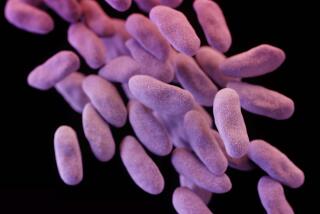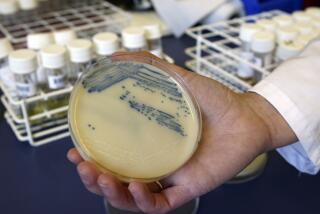A bacterium that destroys tumorsâ dark heart shows promise
A mutant form of a bacterium that lives in soil and thrives in low-oxygen environments appears to be a precise and aggressive killer of malignant tumors as well as an energetic activator of the bodyâs immune system, according to new research.
When scientists injected spores of a weakened form of the bacterium Clostridium novyi directly into the soft-tissue tumors of dogs and that of a single human subject, the results were not only abscesses, fever and pain at the site--all inflammatory responses that showed the immune system had been drawn to the area. In a matter of hours, the bacterial spores quickly found their way into these tumorsâ necrotic cores and began replicating madly, in several cases killing the malignant tissue.
In three of 16 dogs treated with the C. novyi, tumors disappeared altogether and the animals were cured. In three other dogs, direct injection of the bacterium shrank the tumors by at least 30%. In a 53-year-old woman whose myosarcoma--a cancer of the connective tissue--had not responded to conventional treatment, a direct injection of the bacterial spores into one of one metastatic tumors resulted in âextensive tumor destruction.â
Within a day of receiving an injection directly into the tumor wrapped around her shoulder and upper arm, the woman developed a low-grade fever and for about three weeks required intravenous pain medications. But her tumor stopped growing and the bacteria continued to eat away at necrotic tissue in and around the lesion. Roughly six weeks after the injection, the woman suffered a fracture in her necrotic upper arm, which physicians repaired.
The experimental therapy, and the research on mice leading up to it, were reported this week in the journal Science Translational Medicine.
âThis is a cancer therapeutic that is truly different,â said one of the studyâs authors, Saurabh Saha of BioMed Valley Discoveries Inc., a research-and-development organization in Kansas City, Mo., that conducts biomedical research on potential therapies that are too early, unconventional or unprofitable to draw interest from pharmaceutical companies. âWe have to approach it with caution. But the field of cancer immunotherapy is beginning to prove itself, and if it progresses well, this can be another weapon in the cancer armamentarium.â
As a next step, researchers at eight sites across the United States have launched an early clinical trial of the bacteriologic cancer therapy. Researchers plan first to test the safety of the therapy on volunteers with solid malignant tumors of all kinds who have been treated with at least one systemic cancer medication and who have no options for curative therapy.
Outside experts hailed the new research as promising, but cautioned there were substantial issues of safety and effectiveness to be worked out before it could be ready for widespread use. Inducing bacterial infections in any patient is tricky business, they noted: By activating a robust immune response, such an infection might rally the bodyâs disease-fighting powers directly to the site of cancer, but it might also kill the patient.
âWe have to harness the promising aspects of this treatment while minimizing the potential toxicity,â said Basel al-Ramadi, an immunologist at United Arab Emirates Universityâs College of Medical and Health Sciences who was not involved in the current research. âUntil we sort that out, it will continue to be a limiting factor.â
The articleâs senior authors call the proposed bacterial therapy a form of âbio-surgeryâ: Applied directly to the site of a tumor, the method deploys a strain of anaerobic bacteria to attack with precision a recognized weakness of malignant tumors--that in its frenzy of growth, cancer often overreaches, generating zones that are not yet serviced by a network of blood vessels.
This oxygen-starved cancer tissue is hard for chemotherapy to reach, and often doesnât respond to radiation therapy either. At a minimum, researchers at Johns Hopkins Universityâs Kimmel Comprehensive Cancer Center hoped, a bacterium that invaded and killed such tissue could be used as an adjunct to conventional chemotherapy; in some cases, they wondered whether it might cause a tumor to shrink so much that the cancer would simply go to ground.
Itâs not a new idea: Medical cases as much as a century old offer accounts of cancer remission in patients who contracted serious bacterial infections. Those set Hopkins oncologist Shibin Zhou and his lab to explore the potential power of anaerobic bacteria, which thrives in tissue with little oxygen, to home in on these necrotic zones.
Zhou, one of the paperâs senior authors, found strains of Clostridium whose spores would move quickly into a tumorâs oxygen-starved regions and release an enzyme that killed cells there. In a bid to find a strain less likely to kill the patient as well as the cancer, Zhouâs team screened samples of Clostridium novyi for weakened versions of the strain. They found one that lacked the gene necessary to create some of C. novyiâs most potent toxins, cultivated it, and injected it into rodents who had had glioblastomas--small, widely distributed tumors--in their brains.
The C. novyi shrunk those tumors, causing many to disappear. But while glioblastomas neatly fit the profile of oxygen-starved tumors to which C. novyi are drawn, Zhou cautioned that the experimental therapy was likely to remain a poor choice for brain cancers, because bacterial infections in the brain are almost always disastrous.
Dr. Gavin Dunn, a University of Washington neurosurgeon who was not involved in the latest research, noted that half of the treated dogs developed some type of abscess.
âThis suggests that this type of treatment should be considered only in locations were abscess treatment is low-risk and tolerable,â said Dunn. Given the challenges of treating cancers that resist standard treatments, he said, âwe should be open to new therapies.â But patients and physicians would be justifiably wary of a treatment that risked causing abscess or ventriculitis in the brain, he added.
In an interview, Zhou underscored that the C. novyi strain used was naturally occurring. That, he added, leaves open the possibility of further improvement of the bacterium with genetic engineering.
The researchers focused on soft-tissue tumors as a useful proving ground, since such malignancies are often wrapped around or embedded in normal, healthy oxygenated tissue. Such tumors would give C. novyi the chance to demonstrate that it would attack cancerous tissue and leave healthy tissue intact.
Ramadi, of the University of United Arab Emirates, said that a delayed injury in the studyâs lone human subject might cause some worry on this front: 55 days after she received the therapy, the womanâs upper arm was found to have been fractured after exertion--a sign that the bacterial therapy may have weakened necrotic bone tissue as well as her tumor.
Ramadi added that the latest study also did not demonstrate that the C. novyi prompted an âadaptiveâ immune response, one that is trained on a particular disease-causing agent and limits itself to fighting that alone. The presence of abscesses, pain and fever in dogs and in the studyâs lone human subject suggests that the injections of C. novyi spores did set off a generalized immune response. But many cancer immunotherapies, he said, aim to focus the immune systemâs power on the cancer alone.
BioMed Valley Discoveries is overseeing the early clinical trial, recruiting subjects at sites including the MD Anderson Cancer Center in Houston, the Cleveland Clinic and the Memorial Sloan Kettering Cancer Center in New York.







